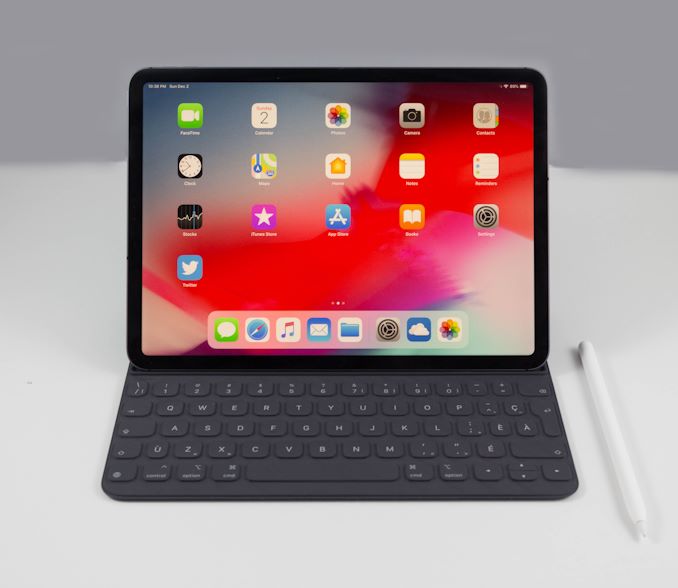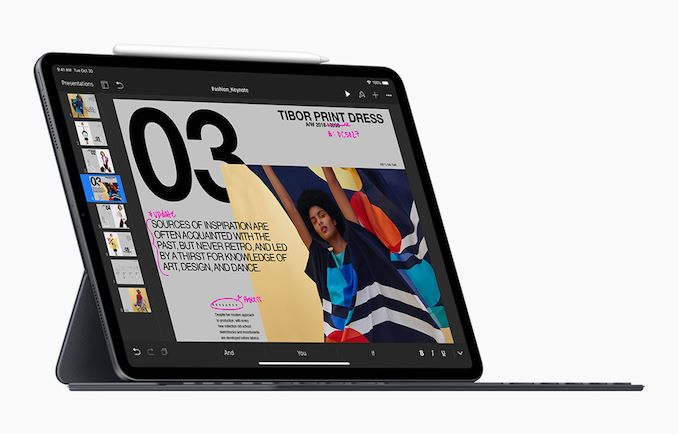The 2018 Apple iPad Pro (11-Inch) Review: Doubling Down On Performance
by Brett Howse & Andrei Frumusanu on December 4, 2018 10:00 AM EST
I think it’s safe to say that in 2018, the tablet market has not shaped up like anyone had expected, not even Apple. Tablets weren’t the next smartphone – and indeed the sales of dedicated tablets are downright soft – and yet at the same time tablets have successfully carved out a meaningful niche for themselves. But more importantly still, the tablet concept is everywhere even if “pure” tablets themselves aren’t. One needs only look at all the various PC 2-in-1s and convertibles to see the influence tablets have made on the traditional laptop market, forcing these many clamshells into becoming something more.
As a consequence of the introduction of modern tablets and their subsequent efforts to secure their own place in the market, we’ve essentially seen the tablet and tablet-alike market bifurcate into two real clusters of tablet designs. On the one hand are the cheap content consumption devices – the iPads, Fire TVs, and myriad of cheap Android tablets. On the other hand is the far more exclusive market for high-end, productivity-oriented tablets; devices that don’t just consume content, but create it as well. This market has been slower to develop, but it’s also important for its own reasons, as it’s the real crossover point between tablets as envisioned by the iPad, and the traditional PC laptop market.
Apple for their part has opted to go after both of these markets, and has done so successfully. The traditional 9.7-inch iPad needs no introduction, and while the iPad Pro is a little less known, the difference isn’t by much. Built upon the shoulders of the original iPad, the iPad Pro family takes things one step further, building towards not just a bigger and better iPad, but by giving the tablet the features that are needed for productivity and content creation, at both a hardware and a software level. The iPad Pro doesn’t try to be a traditional laptop, but it certainly tries to capture a lot of their usefulness, and this is especially the case for the 2018 iPad Pro.
With the introduction of the latest iPad Pro models, Apple’s iPad lineup for 2018 offers arguably the largest design change since the original iPad launched. The new design offers a much higher screen-to-body ratio than ever offered before, mimicking what they’ve done with the iPhone lineup. As a result, Apple has more or less reinvented the iPad Pro design, and offers plenty of new features inside and out.
Apple’s ambitions with the iPad Pro start with their chip design team, which has created the Apple A12X System on a Chip to power the latest iPad Pro. As outlined in our iPhone XS review, the A12 series of SoCs are already well ahead of the ARM competition, and Apple clearly has its sights on the performance levels of x86 CPUs from Intel. A12X features four Apple Vortex CPU cores, double that of the regular A12 in the iPhone, and seven A12 GPU cores which Apple says provides the power of an Xbox One S in a device with a far smaller power budget.
For better or worse, the iPad Pro is attached at the hip with Apple’s mobile operating system iOS, and unsurprisingly the iPad Pro ships with the latest version, iOS 12.1.
Apple’s iPad Pro lineup has also been their test bed for their newest display technology, and the iPad Pro keeps the 120 Hz ProMotion display, which offers variable refresh rate down to 24 Hz, along with P3 display gamut coverage tied in with their color managed software. Apple also keeps their True Tone option to dynamically adjust the white balance of the display to match the lighting conditions of the room it’s in.
|
Apple iPad Pro Comparison |
||
| iPad Pro 11-Inch (2018) |
iPad Pro 12.9-Inch (2018) |
|
| SoC | Apple A12X 4x Apple Vortex 4x Apple Tempest 7 core A12 GPU |
|
| Display | 11-inch 2388x1668 IPS LCD P3 D65, 120Hz |
12.9-inch 2732x2048 IPS LCD P3 D65, 120Hz |
| Dimensions | 247.6 x 178.5 x 5.9 mm 468 / 468 grams (WiFi / LTE) |
280 x 214.9 x 5.9 mm 631 / 633 grams (WiFi / LTE) |
| RAM | 4 GB (up to 512 GB Storage) 6 GB (1 TB model) |
|
| NAND | 64GB / 256GB / 512GB / 1TB | |
| Battery | 29.37 Wh | 36.71 Wh |
| Front Camera | 7MP, f/2.2, Smart HDR, Wide Color Gamut, Retina Flash | |
| Rear Camera | 12MP, f/1.8, PDAF, Smart HDR, Wide Color Gamut, True Tone Quad-LED flash |
|
| Cellular | 2G / 3G / 4G LTE (Category 16) Intel XMM 7560 Modem |
|
| SIM Size | NanoSIM | |
| Wireless | 802.11a/b/g/n/ac 2x2 MIMO, BT 5.0, GPS/GLONASS | |
| Connectivity | USB-C Apple Smart Connector |
|
| Launch OS | iOS 12.1 | |
| Launch Price | Wi-Fi: $799 (64GB) $949 (256GB) $1149 (512GB) $1549 (1TB) Wi-Fi + LTE: $949 (64GB) $1099 (256GB) $1299 (512GB) $1699 (1TB) |
Wi-Fi: $999 (64GB) $1149 (256GB) $1349 (512GB) $1749 (1TB) Wi-Fi + LTE: $1149 (64GB) $1299 (256GB) $1499 (512GB) $1899 (1TB) |
Apple has also taken the opportunity to switch the iPad Pro lineup over from their proprietary Lighting connector to the more ubiquitous USB-C port, making this the first iOS device to offer USB connectivity. Where they give, they also take away though, and the 3.5 mm headset jack has gone the way of the Dodo, and for more or less the same reasons.
For those that want to work on the go, Apple continues its excellent tradition of offering cellular connectivity with the iPad Pro, and those that need a lot of storage will be happy to see models up to 1 TB, which is more important because the iPad offers no way to access external storage to increase this.
What first set the iPad Pro apart from the rest of the iPad lineup was the ability to use the Apple Pencil as well as a first-party keyboard solution. For the 2018 iPad Pro, both of these accessories have gotten refreshes as well.
The iPad Pro for 2018 is a major change from the outgoing models. Let’s dig in and see how it fares.











145 Comments
View All Comments
melgross - Tuesday, December 4, 2018 - link
I find Affinity Photo to be clumsy. It’s pretty buggy in some areas too. There are a number of pretty good photo apps for iOS though, in addition to Photo. I like Enlight and Lightroom CC as well.The Garden Variety - Wednesday, December 5, 2018 - link
I've never understood all the obsequious praise for Affinity Photo, and all the Affinity apps, really. They're unbelievably buggy, the company that produces them, Serif, is constantly on the edge of financial failure, they've missed every single one of their publicly stated development deadlines, and their tech/customer support is basically non-existent. Their user forums are this uncomfortable mix of people praising them like the second coming of their lord and savior, or complaining bitterly about the most ridiculously basic features for these classes of software being missing or broken.This is the "Adobe killer" everyone keeps crowing about? Please. They'll be dead and buried inside of five years. Meanwhile, Adobe will hum along printing money.
ChrisH362 - Tuesday, December 4, 2018 - link
In the article, you mentioned “A more telling test, perhaps, will be once Adobe has ported over the full-fat version of Photoshop to the iPad, which is expected next year.” Instead of waiting on Adobe, why not use Affinity Photo from Serif? They have working versions for iPad, Mac, and Windows and works just as well if not better than Photoshop.id4andrei - Tuesday, December 4, 2018 - link
Since APIs and shader precision are different or obfuscated at times, how is this an apples to apples comparison? The same game might run different resources on ios compared to its windows versions. FP16 will always be faster than FP32 especially on custom built hardware for it.tipoo - Tuesday, December 4, 2018 - link
I think it's still a worthy comparison, because the MX150 and 1060 can't use double rate FP16, so it's tailoring to the strenghts of what all of them can do.Landing so close to the 1060 is eye popping with almost no cooling. I can't wait to see these in clamshells with fans.
KPOM - Tuesday, December 4, 2018 - link
Could you post charging times using a standard 60W USB-PD charger, to take chargers out of the equation? That would be helpful to know.tipoo - Tuesday, December 4, 2018 - link
I'm not sure how to read the "peak" box in the corner of the GPU charts - are only the grey bar devices measured at peak?Brett Howse - Tuesday, December 4, 2018 - link
No it just means the scores are peak results and not sustained.darkich - Tuesday, December 4, 2018 - link
Well at this point I guess I can safely say I am disappointed by Andrei's methodology and conclusions regarding performance comparisons.He's missing the FACT that iPad Pro is shown to be FAR faster than any laptop shown here in the actual real life performance (4K video editing).
It will render the same material in the same way, much faster.
How is that not a legit and clear absolute performance metric??
darkich - Tuesday, December 4, 2018 - link
..on a side note, NONE of this ultimately matters for one simple reason - the build quality, I.e. structural integrity.The iPad Pro is a POS that should be recalled.
A tablet that one can *easily* snap in half with bare hands, is not a legitimate product.